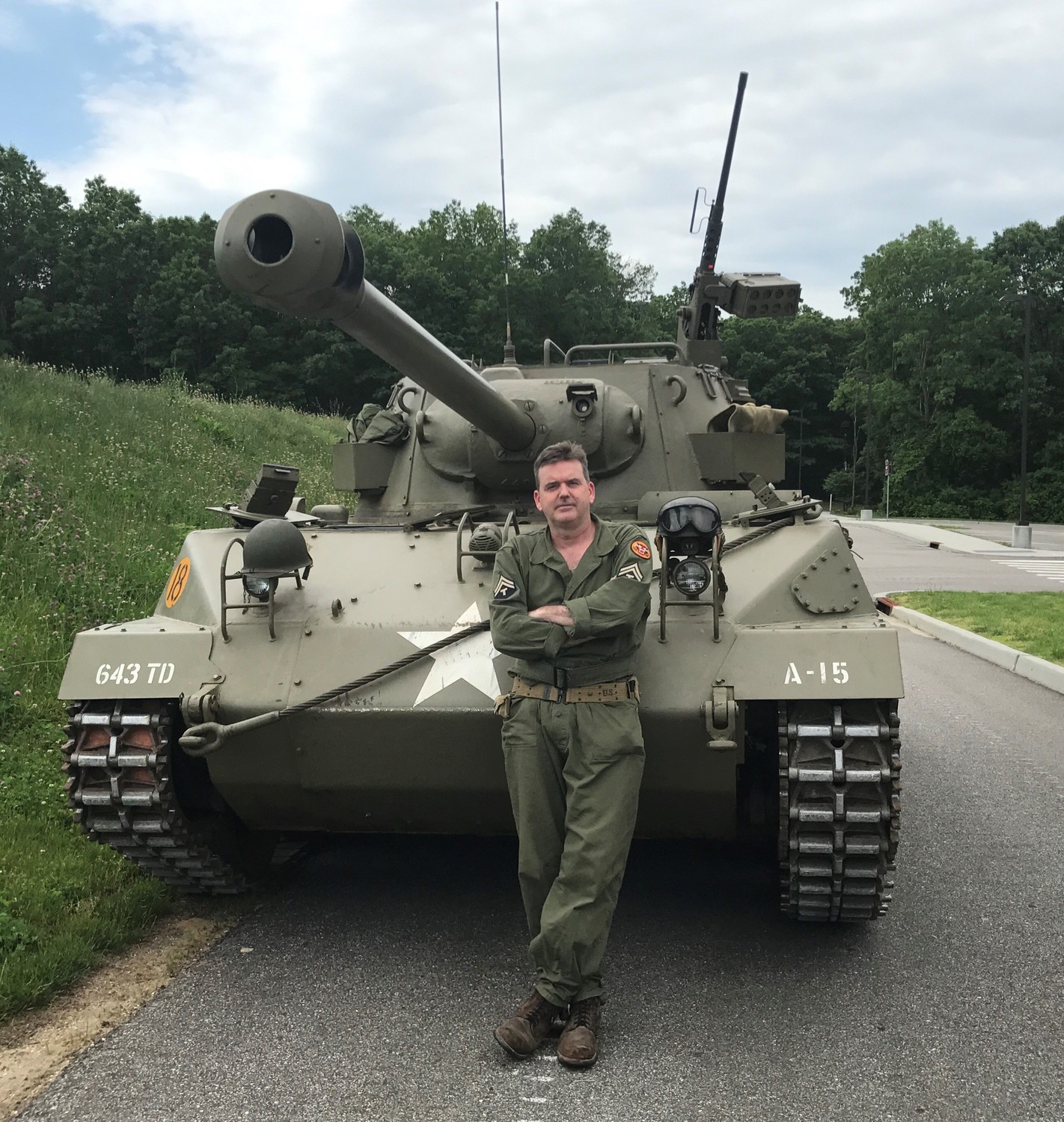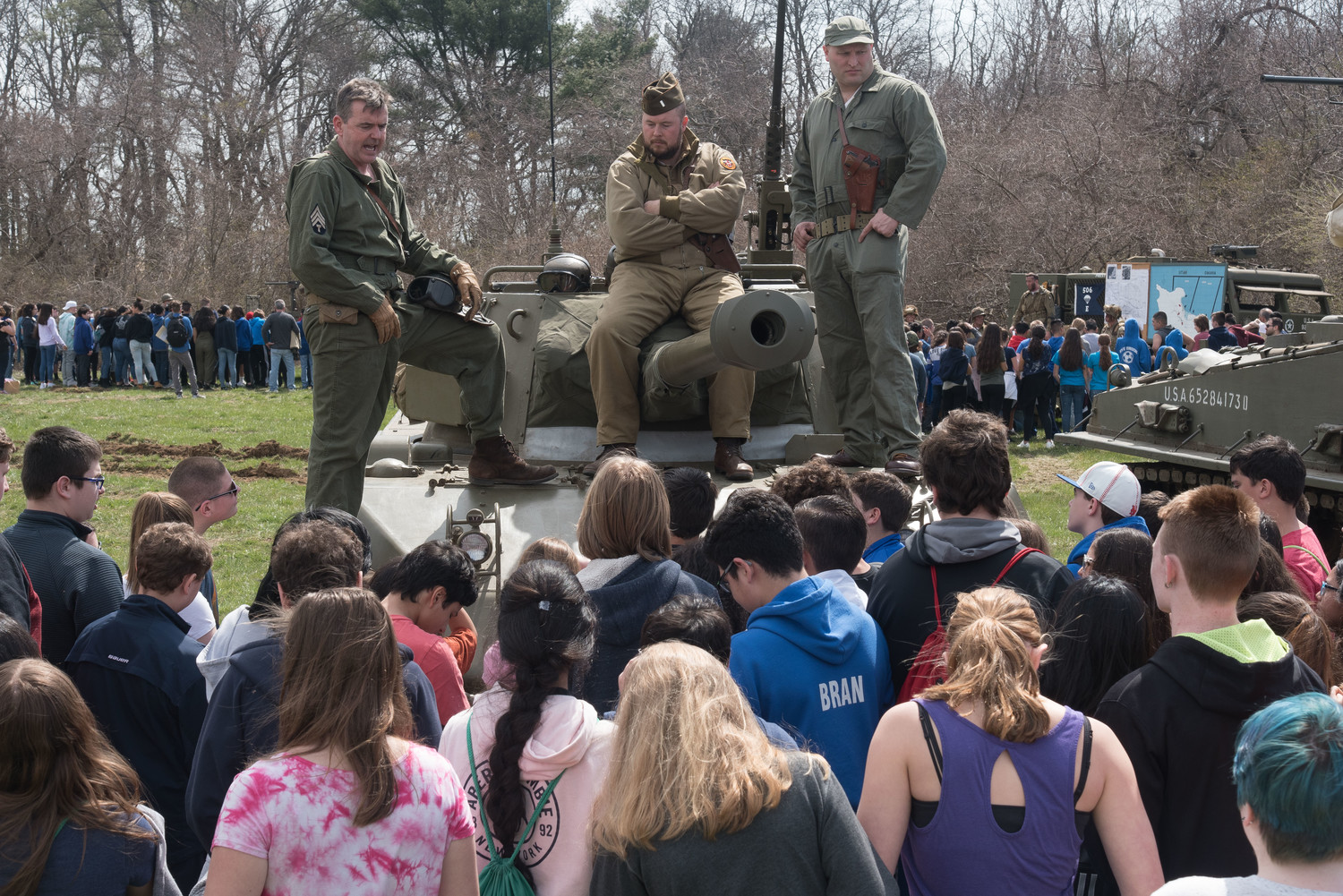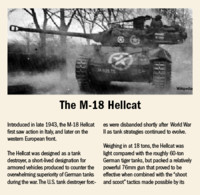Oceansider, Royal Navy vet, re-enacts the world wars
As second-in-command of the five-man crew aboard an American M-18 Hellcat tank destroyer, Tech Sgt. Michael Justin is the vital relay between its commander — whose position in the cramped crew compartment of the 18-ton World War II-era vehicle offers him the greatest visibility of the battlefield — and its driver, gunner and loader.
“Everyone knows everyone’s job,” Justin, 49, said of the men, who will take part in the upcoming Labor Day weekend re-enactment at the Museum of American Armor in Old Bethpage. They will show off the nearly 75-year-old tracked, turreted vehicle in action — wearing the uniforms of the time — while fellow crews demonstrate various other armored vehicles, or “heavy steel,” as Justin described them, not exclusive to those used in World War II.
Justin has spent many of his weekends for the past three years taking part in such historical re-enactments, focusing on the first and second world wars. Despite his Irish lilt — he is a native of Belfast, Northern Ireland — he described himself as a “local boy from Oceanside,” where he has spent the past 23 years.
He said that he and his four comrades have become intimately acquainted over the years with Grace, or Amazin’ Grace, as the crew calls the M-18 — which was introduced late in the war as one of the many attempts by American generals to counter the technological superiority of the German tanks of the time. They have memorized every button, cog and lever, along with the contents of the beast’s U.S. Army-issued manual. “We live and breathe that M-18,” Justin said.
“The M-18 is such a unique vehicle,” he explained, noting that with light protection and excellent maneuverability, “its speed was its armor.” Justin said that he and his fellow re-enactors’ dedication to accurately depicting how soldiers went about fighting in the war borders on an obsession, as they try to get every detail right. “Not a day goes by that we’re not working and thinking about World War II,” he said, “and learning.”
Re-enactments, Justin said, serve several purposes, including teaching younger generations about watershed historical moments such as major wars. Most important, he said, they are about recognizing the men and women who fought in World War II, “the greatest generation,” as they have become known. “Honoring the veterans is always top priority,” he said. “… It’s very important to me to recognize them, especially since we’re losing 360 of them a day.”
It can be a tremendous time commitment, he said, and requires a constant balance between the needs of the Long Island re-enactment community, and home life, where he is married and has three daughters and a son.
“Is there an event every weekend that you could be at? Yes,” Justin said. “But can you be there? Not necessarily.”
A veteran himself
Three of the five members of the tank destroyer’s crew are veterans, including Justin, “a good ratio,” he said.
From 1987 to 1993, he served as a diver in the British Royal Navy, specializing in underwater mine disposal. Justin took part in the 1991 Persian Gulf War, he said, where he disposed of underwater Iraqi mines in the waters off Kuwait.
For nine months, he and the crew of the HMS Bicester, the British mine countermeasure vessel on which he served, would detect and dispose of the mines. It was a painstaking process, he said, in which divers were sent down — one at a time, in case of an accidental detonation — located the mines by touch (flashlights were prohibited), returned to the surface, where they were handed a detonation pack, returned to the bottom plant the explosives, and carried a fuse to a dive boat, where it was lit. The small craft then had about a minute to escape the blast radius, he said.
“We would be down there for a considerably long time,” Justin said. The Iraqis deployed 16 types of mines, according to New York Times archives, the most dangerous of which, he said, were those designed to rest on the seabed. The shockwave the mine created would have to reach the surface in order to be effective, he said, “So the amount of explosives would be massive.”
All in all, the Bicester disposed of 75 mines during its time in the Persian Gulf — the most, at the time, of any single warship since World War II, Justin noted, as the Coalition fleet inched closer to the Iraqi shoreline.
It was through his service that Justin met his future wife, Patricia Amthor. As a sailor fresh out of basic training, he was approached by a high school friend who suggested they take up pen pals. They sent letters to an acquaintance in the U.S., asking her to see if any friends would be interested in taking part in the exchange. When the pair and friends received their first package, it was filled with photos of girls and their letters. “I picked up the first pictures that fell beside me and took the letter that went with it,” Justin recounted.
He and Patricia, an Oceanside native, struck up a correspondence, but it wasn’t until the fall of 1991, after his tour in the gulf ended, that he decided to visit, and the two met in person. “I fell instantly in love,” he said, and without her knowledge, he returned to the British navy to ask for a discharge so he could get married. “I was that smitten,” he said.
Justin initially worked as a commercial diver when he came to the states, repairing underwater infrastructure such as bridges and piers. Later he was a paramedic, serving as a first responder on Sept. 11, 2001, and then made the transition to emergency management and preparedness. Now he is chief operating officer at a firm that develops crash-avoidance radar systems for motor vehicles.
The couple celebrated their 25th wedding anniversary in July. “We always joke that I had to come halfway across the world, and she only moved a block away from where she grew up,” he said.
A history of service
Coming from a family with a long history of military service, Justin said he initially became interested in re-enacting to honor his great-grandfathers, Thomas McCartney and John Mullen, who served in the Royal Irish Rifles and Royal Field Artillery regiments during World War I. Justin uses the Irish Rifles’ crest and motto, “quis separabit,” or “Who will separate (us)?” to sign his emails.
“I have their faces looking at me every day, all of their medals looking at me every day,” he said. “All of the military history of my family hangs on my walls … I was the first generation to come to the U.S. I wanted my children to know, ‘Here’s what we did over there.’”
It was through those initial re-enactments that he became acquainted with the Museum of American Armor, and was drawn by its volunteers’ dedication to restoring and maintaining its stock of vehicles. Eventually, he was assigned to the M-18.
Justin’s tank commander, Al Barto, who is the director of operations at the Intrepid Museum in Manhattan — and actually owns the M-18 — said that Justin’s interest in being a part of Grace’s crew goes well beyond taking the tank destroyer for joyrides.
“I took a liking to him right away,” Barto said. “He really knew his stuff and wanted to be involved.” He added that Justin is indispensible when it comes to helping maintain the M-18.
As an eight-year veteran of the Marines himself, Barto said it was important to preserve machines such as the Hellcat to honor the memory of the soldiers who served in them. “As veterans, we appreciate the sacrifices that these men made,” he said, “but if nobody’s there to tell their story, they would just be forgotten.”
For Justin, Barto and their fellow re-enactors, each day is a chance to hone their craft, learn more about everything from uniforms to hardware, and get that much closer to mirroring exactly how soldiers of bygone eras lived.
“When I look at the opportunity I have and how we’re able to make everything come together, we’re really bring history to life,” he said. “There’s really not a day that goes by that you don’t learn something new.”

 47.0°,
Mostly Cloudy
47.0°,
Mostly Cloudy 









